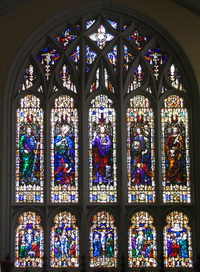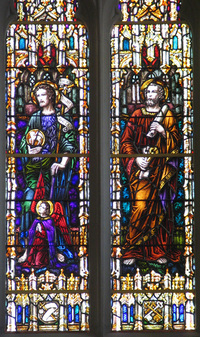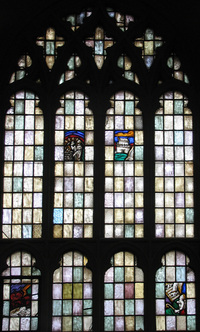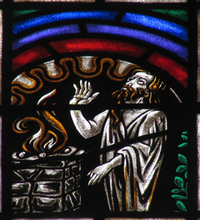MSGC : Featured Windows : Current Window
Featured Windows, September-October 2009
First Congregational United Church of Christ
Building: First Congregational United Church of Christ
City: Kalamazoo
State: Michigan
First Congregational United Church of Christ, Kalamazoo, Michigan. Built in 1928 by architect Aymar Embury, II of New York.
First Congregational United Church of Christ of Kalamazoo was organized as a Presbyterian church by fourteen Michigan pioneers in 1835, two years before the territory became a state. In 1842 the church changed to a Congregational form of government and in 1961 it affiliated with the United Church of Christ. Its fourth home, designed in an English Gothic style by New York architect Aymar Embury II, was completed in 1928 to replace an earlier 1890 church building destroyed by fire in 1925.
The stained glass windows of the church were created by three studios during different eras. The earliest windows were made in the late 1920s by the A. L. Brink Studio of New York City; one window in the sanctuary south wall was designed in the 1930s by Nicola D’Ascenzo and fabricated by the D’Ascenzo Studio of Philadelphia; and the chapel windows were made during 1959, 1960 and 1972 by the Willet Stained Glass Studios of Philadelphia.
The Memorial Window in the chancel area, given in memory of Rachel Babcock Upjohn, was created in the late 1920s by the A. L. Brink Studio and signed Alfred E. Floegel pinx (painter), and A. L. Brink fecit (fabricator). The 12’ x 24’ window presents the “Life of Christ” on two levels of five panels each. Large panels on the upper level include the central figure of Christ as the Peace Maker, holding a globe surmounted by a cross and raising one hand to bless the world. At his left are figures of his mother Mary and St. Paul, holding a book and sword; to his right are figures of his cousin John the Baptist, clad in a rough camel’s hair shirt, and St. Peter, holding a scroll and keys. Smaller panels on the lower level include familiar scenes in the life of Christ: the Nativity, Baptism, Crucifixion, Resurrection and Ascension.
Left: The Memorial Window. A. L. Brink Studio, NYC. Late 1920s.
Right: John the Baptist and St. Peter. Detail of the Memorial Window.
The A. L. Brink Studio also created the clerestory and nave aisle windows. Twelve 10’ x 20’ clerestory windows along the east and west sides of the nave contain approximately 370 pieces of glass each, most of the pieces painted in a matte finish. Each window on the west side includes four small scenes from the Old Testament, while those on the east side feature little scenes from the New Testament, a total of 48 scenes in all.
Fig. 4. West Side Clerestory Window with Old Testament scenes of Noah’s Offering, the Tower of Babel, the Destruction of Sodom, and Jacob’s Dream. Alfred E. Floegel, A. L. Brink Studio, NYC. Late 1920s.
Left: Detail: Noah’s Offering.
Right: Detail: Tower of Babel
Left: Detail: Destruction of Sodom.
Right: Detail: Jacob’s Dream
East Side Clerestory Window with New Testament scenes of the Baptism of Jesus, Jesus enters into Jerusalem, Jesus Preaching from a Boat, and Return of the Prodigal Son. Alfred E. Floegel, A. L. Brink Studio, NYC. Late 1920s.
Left: Detail: Baptism of Jesus.
Right: Detail: Jesus enters into Jerusalem.
Left: Detail: Jesus Preaching from a Boat.
Right: Detail: Return of the Prodigal Son.
The Education Window in the south wall of the sanctuary, designed by Nicola D’Ascenzo, represents the influence of Christianity on various fields of human achievement. Depicted among the almost life-size figures are nurse Florence Nightingale, Bible translator John Wycliffe, sculptor Michelangelo, poet and playwright William Shakespeare, President Abraham Lincoln, scientist Louis Pasteur, composer George Frideric Handel and other individuals who contributed to the betterment of mankind.
Left: The Education Window. Nicola D’Ascenzo, D’Ascenzo Studio, Philadelphia, PA. 1930s.
Right: Detail of Education Window. At the left of the central figure of Jesus are depictions of St. Paul, Lyman Abbott and John Wycliffe. Michelangelo, Shakespeare and Erasmus are in the far left panel.
The chapel windows of First Congregational United Church of Christ were created by the Willet Stained Glass Studios of Philadelphia. Four windows designed by Marguerite Gaudin were installed in 1959 and 1960. The John Robinson Window designed by Colum Sharkey was added in 1972.
Left: Chapel Window. Marguerite Gaudin, Willet Stained Glass Studios, Philadelphia, PA, 1959. This is one of three two-lancet windows that represent the life of the church. A fourth three-lancet window in the chapel depicts the life of Christ.
Right: John Robinson Window. Colum Sharkey, Willet Stained Glass Studios, Philadalphia, PA. 1972. John Robinson (1576-1625) was pastor of the separatist group of English Pilgrims at Leiden, Holland, where he preached and wrote on the separatists’ position. He encouraged their emigration to America in 1620 but remained at Leiden with most of his congregation. His followers who settled at Plymouth, MA, brought with them the principle of Congregationalism, whereby each church is self-governing.
First Congregational United Church of Christ was registered in the Michigan Stained Glass Census by Valerie J. McCartney, with photography by John McCartney, owners of Full Spectrum Stained Glass, Inc., of Colon, MI. The windows were restored by Full Spectrum Stained Glass between 1999 and 2007.
Bibliography:
Show BibliographyAymar Embury II. “Our Appreciations.” Dedication and Memorial Book. First Congregational Church, Kalamazoo, Michigan, 1928.
"John Robinson." The Columbia Encyclopedia, Sixth Edition. 2008. Encyclopedia.com. (September 13, 2009). http://www.encyclopedia.com/topic/John_Robinson.aspx
“Historical Sketch.” Dedication and Memorial Book. First Congregational Church, Kalamazoo, Michigan, 1928.
First Congregational United Church of Christ. “History in Kalamazoo”. http://www.kazoofcc.org/
The Holy Bible, King James Version. (New York: American Bible Society, 1999). Published May 2000 by Bartleby.com; ©Copyright Bartleby.com, Inc.
Keith, Dr. William A. “The Stained Glass Windows and Other Art Works in the Sanctuary and the Chapel of First Congregational Church of Kalamazoo, MI.” First Congregational Church, Kalamazoo, MI. 1992.
Keith, Reverend William A. “This Far by Faith, a Sesquicentennial History of the First Congregational Church of Kalamazoo, Michigan 1835-1985.” First Congregational Church, Kalamazoo, MI. 1985.(MSGC 1997.0030)
Text by Betty MacDowell, Michigan Stained Glass Census, September , 2009.






